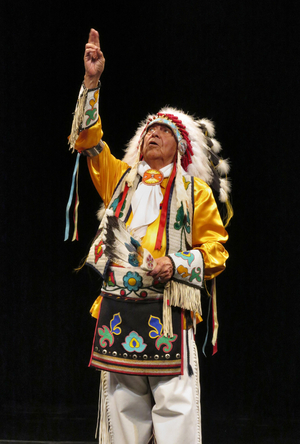BWW Exclusive: Louis Mofsie, Director of the Thunderbird American Indian Dancers Talks the Company's Mission & More

Louis Mofsie, the director of the Thunderbird American Indian Dancers has penned an article exclusively for BroadwayWorld, discussing the Thunderbird American Indian Dancers' history, their hope in correcting stereotypes about Native dance and culture, and more.
Read his article below.
My name is Louis Mofsie, I am the director of the Thunderbird American Indian Dancers, the oldest resident Native American Indian dance company in New York City, celebrating our 57th year this year.
My Native American background is Hopi and Winnebago. My Father is from the Hopi tribe from Arizona and my mother is from the Winnebago tribe from Nebraska. I myself was born in Brooklyn, NY. I consider myself to be part of the first generation of Native Americans born off the reservation. During my early years I remember my father always singing to me and my sister, he sang Hopi songs and showed us many dances. I always say as soon as I learned how to walk I was dancing, as a result singing and dancing have always been a part of my life. Those early years greatly influenced me to eventually pursue forming a Native American dance company.
Growing up in New York City has been a great experience. Meeting so many people from so many different cultures from around world, witnessing their traditional dances and music made me want to have the Native American dance and music included.
After attending college and teaching for 35 years I retired and it then allowed me to devote myself to developing the Thunderbird American Indian Dancers. I, like many members of the group had been dancing as we grew up but we had not yet created a a formal dance company. Several other Native young people also first generation off the reservation came together to formally organize. We had all been friends growing up and all had a great interest in learning and preserving the dances and music of our culture.
During the summer we would travel to many different parts of the country visiting many different tribes and reservations, our trips primarily were to learn the songs and dances of the different groups we visited. We traveled all through the southwest, northeast, southeast the great plains and also Alaska to learn the dances of the Inuit people. Our goal is to preserve and perpetuate the traditional music and dance of the Native American people, and to bring before the general public a more realistic understanding of our cultural through our music and dance.
We make it very clear that we are doing social dances, because among many of the tribes today they still practice their own Native religions and as part of that belief many songs and dances are sacred, thus dances are closed to outsiders and non-natives. On many occasions during our travels we have joined in the social dances when visitors are invited to participate. During our performances we explain each dance, its tribe, origin, significance and what the movements represent. We feel this is vitally important because not all tribes have the same style of movements.
It is our hope this helps to correct all the stereotypes people have about Native dance and culture.
We have traveled all over the United States, performed at many colleges, schools and other educational institutions, and we have also been on tour in Japan and Israel.
I, as the director of the company, always want to give our dancers the greatest respect. Many of them have been with the company for over 20 years. Their loyalty and devotion to our work is outstanding and their dedication is what has made the company what it is today.
Last year I was very fortunate to receive a Bessie award for contribution to the dance world. As part of my acceptance comments, I made it clear that I accepted the award on behalf of the Thunderbird American Indian Dancers and I thanked the Bessie committee for finally formally recognizing Native American dance as truly the beginning of dance in America.
If you are an artist of color and would like to share your stories, your work, and your experiences, or to recommend someone else that we should get in touch with for one of our initiatives, please feel free to email us at contact@broadwayworld.com.
Videos

